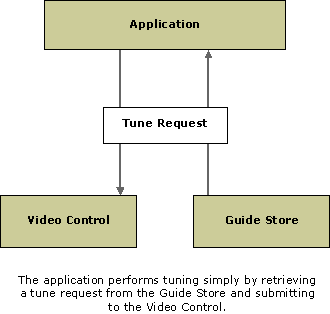
| Microsoft DirectX 8.1 (C++) |
Microsoft® TV Technologies enables the rapid development of digital and analog TV applications by providing high-level objects that simplify filter graph management and standardize the tuning process for all network types. These objects are the Video Control, the Guide Store, and the Tune Request. The relationship between these objects and the application is shown in the following illustration.

The Video Control: The Video Control is a lightweight, efficient ActiveX® control that applications use to create and manage analog and digital TV filter graphs. Any ActiveX container can host the Video Control, including a Visual Basic® form, a Web page running in Microsoft Internet Explorer, or a Microsoft PowerPoint® presentation. For more information, see Video Control.
The Guide Store: The Guide Store is a persistent storage mechanism, or database, for Electronic Program Guide (EPG) information and tune request objects. Applications retrieve EPG information from the Guide Store to create user interfaces that show program schedules. When the user makes a selection, the application retrieves the tune request associated with that program, and simply passes it to the Video Control. The Guide Store is populated by a separate third-party component called a Guide Store Loader, which obtains the EPG information either in-band or from some other source such as a Web page. For more information, see Guide Store.
The Tune Request: The tune request is the primary object in the abstraction layer called The Microsoft Unified Tuning Model. It contains the information required for the Video Control to construct the filter graph, and for a digital TV device to tune to a particular broadcast service. Tune requests are typically created by a Guide Store loader, not by applications. For more information, see The Microsoft Unified Tuning Model.
Note The Guide Store and Video Control are available in Windows XP Home Edition and Windows XP Professional only. For applications intended to run on Windows 98SE, Windows 2000, and Windows Millennium Edition, see Writing Digital TV Applications with DirectX 8.1.